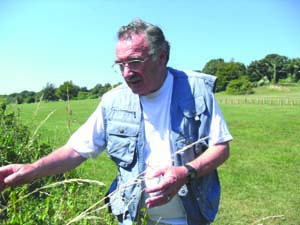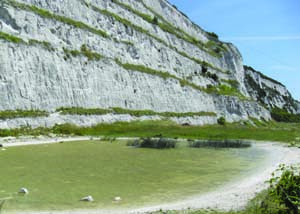|
The Girdled Snail Hygromia cinctella (Draparnaud 1801) is a common Mediterranean species of land snail introduced into England, being first noted in Devon in 1950. It has spread rapidly and is now found in many areas of southern England. This attractive little snail, which measures about 1 cm across, varies in colour from a yellowish white through shades to a dark chocolate brown. It has a sharp keel around the centre of the body whorl, with a light yellowish white band present around the keel. Given that its natural habitat is in the warm environs of the Mediterranean, I have observed this species in my garden active on melting hoar-frost on a sunny winter morning. While preparing a list of local records of Hygromia cinctella (Draparnaud 1801) to send to the Non-Marine Recorder, I received my July copy of Mollusc World, and discovered it contained an article by Dr June Chatfield giving sites in Hampshire for this species (see also "Hygromia cinctella still on the move"). This prompted me to write this account on the sites at which I have collected H. cinctella, particularly in the county of Hampshire, but also in Dorset and Cornwall. In 2003 John Llewellyn-Jones, a close conchological friend, had expressed an interest in finding specimens of Cepaea hortensis (Muller, 1774) with a brown lip. I invited him to stay with me for a couple of days and we planned to visit an old local boyhood collecting haunt on Portsdown Hill, where I knew brown lipped C. hortensis could to be found. We set off for the site on the 22nd July 2003which was a pleasant warm summer day but a little dry for snail activity and snail collecting. The site we visited is situated above Drayton, Portsmouth, on the lower slopes of Portsdown Hill (SU 669063) at the northern end of Upper Drayton Lane. It consists of a small chalk pit surrounded by sloe and blackberry bushes, Old Man’s Beard, nettles and grass. The colony of C. hortensis last visited by me in 1958, is sited on the upper east border of the chalk pit. I am pleased to say that the colony containing the brown lipped variant of the White Lipped Snail still survives here, although in far smaller numbers than was the case all those years ago. It was a dry warm day and snails were inactive, and this may in part have accounted for the small numbers of snails found. Quite by chance on the east upper border of the chalk pit (SU 671063) I found a mature living example of the Girdled Snail Hygromia cinctella. Looking around in the immediate area, this single specimen was the only one I could find. However some distance away at the top of Abadare Ave (SU 669063) (Figure 1), a dead end road with steps leading onto Portsdown Hill, a considerable number of both live and recently dead specimens were found among Old Mans Beard. The species was obviously well established at this site, which is immediately next to domestic gardens. Since that time I have discovered a total of some 12 Hampshire sites for H.cinctella, with a further 3 in Cornwall, and 1 in Dorset. Most of the discoveries have been quite accidental, only about four sites were found as the result of deliberate searching. All of the Hampshire sites are in a cluster in the south east of the county and fairly close to the sea. Some 5 miles west of the Drayton site and still on Portsdown Hill is another much larger chalk pit, the Paulsgrove Chalk Pit (SU 634066), a site which I discovered on the 22nd June 2008. This was the site of a lime works vacated some 50 years ago and is now a haven for a wide variety of animals and plants. It even has a pond created on a chalk terrace which contains Radix balthica (Figure 2). A number of live specimens of H. cinctella were found crawling over a wall on the south border of the pit, next to the entrance gate and very close to houses. This is an area where local residents dispose of their garden waste, grass and privet cuttings, shrub prunings and dead plants etc. Returning east, I found a cluster of sites for H. cinctella around the East Cosham and the Farlington area, all of which are in domestic gardens about a mile both east and west of the Drayton site. All were live finds and all found in thickly planted domestic gardens: in my daughter’s garden at Lonsdale Ave, East Cosham (SU 677052) on the12th September 2006; in a garden on the Havant Road, at the junction with East Cosham Lane (SU 670053) on the 26th August 2008 among thick ivy; in my father’s garden at Copsey Grove, Farlington (SU 675059) on the 22nd July 2008. There are three records of H. cinctella from the Havant area, all being live finds: in my own garden at Ramsdale Ave, Leigh Park (SU 703084) on the 18th April 2008; in the garden of a veterinary practice in Middle Park Way, Leigh Park (SU 705077) on the 27th October 2008. It was also discovered living on a roadside grass verge in Solent Road not far from the centre of Havant. (SU 715061) on the15th October 2008. On the 31st July 2009, three dead shells were found in a garden on an access road leading to a supermarket in Waterlooville (SU 681093). This site will need to be revisited to determine whether live specimens are present. The final Hampshire site is in the centre of the Gosport peninsular to the east of Fort Brockhurst, on an area of waste land which had been cleared of buildings, near to a superstore (SU 599022) on the 2nd November 2008. If we take the Drayton site as a central point, all the S.E.Hants records discovered so far fall within a radius of 4 to 5 miles. The Dorset location is at the side of a car park in Hinton Road Bournemouth (SZ 091903), found on the 24th October 2003. Live specimens were found in thick ivy on either side of the steps leading from a public car park to the road. Apart from an area of trees around the car park the site is within a built up area and not far from the main Bournemouth shopping centre. Additionally there are three “holiday records” for Cornwall. Firstly on the south coast, on the coastal path at the top of a shore cliff at East Looe, (SX 258533), on the 6th August 1998, where only dead specimens could be found. At West Looe (SX 254536) on the same day live examples were found in the garden of an amusement arcade in flower beds, on the west side of the road bridge which crosses the Looe River. The third Cornwall site was on the north coast at Padstow (SW 919753). Specimens were found crawling on an outcrop of natural rock forming a wall alongside the road through Padstow Harbour in July 2004. All of these records occur close to human habitation, and have a strong association with gardens. This may suggest that the rapid spread of this species is possibly partly through the medium of potted plants as eggs in the plant soil. Strangely I have never found it in local Garden Centers or Nurseries, despite searching and also asking staff, who have no recollection of seeing this distinct little snail at their places of work. I have no doubt the rapid spread of this snail will continue and many more sites await our discovery. All these records are in the process of being sent to the Conchological Society Non-marine Recording Scheme, and most have been sent to the recording scheme being operated for this species by the National Museums and Galleries of Wales, Cardiff. 1see also note by David Harfield and Adrian Brokenshire in this issue. References Kerney. M.P. Atlas of the Land and Freshwater Molluscs of Britain and Ireland, Harley Books, 1999. Cameron R.A.D.& Kerney. M. A Field Guide to the Land Snails of Britain and North West Europe, Collins 1979. Chatfield. J. The Girdled Snail in Hampshire – an interesting mode of dispersal. Mollusc World 20, July 2009. |
|
Hygromia cinctella in southeast Hampshire, Dorset & Cornwall
Issue
21
Page
21
Species

 Figure 1: The author at the Abadare Avenue, Drayton site with Portsdown Hill in the background (Photo: Shirley Wimbleton)
Figure 1: The author at the Abadare Avenue, Drayton site with Portsdown Hill in the background (Photo: Shirley Wimbleton) Figure 2: Paulsgrove chalk pit with pond. (Photo: Terry Wimbleton)
Figure 2: Paulsgrove chalk pit with pond. (Photo: Terry Wimbleton)